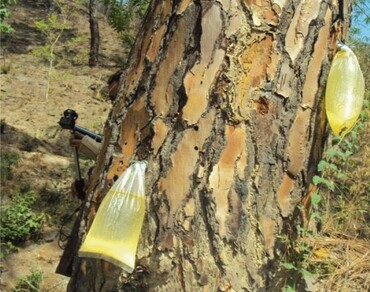Comparative anatomy of resin ducts in some Western Himalayan softwoods
Chauhan Kanica, Sharma K. R., Dutt Bhupender, Chauhan Rajesh
Research Articles | Published: 04 April, 2022
First Page: 935
Last Page: 941
Views: 3339
Keywords: Resin ducts, Fusiform rays, Conifers, Western Himalayas
Abstract
Resin ducts are a common protective structure in Conifers. The oleoresin, a mixture of roughly equal amounts of turpentine and rosin, is synthesized and accumulated in resin ducts. Resin ducts in conifers are considered as the first line of defence against insects and pathogens because of toxicity and sticky properties of resin which repel invading insects and inhibit pathogenic fungi. Present investigation were undertaken with the objective to study the comparative wood anatomy of five coniferous species of Himachal Pradesh. Wood samples of these species were collected from three locations of the state and were studied anatomically under laboratory conditions. It was observed from tangential section of the wood samples that there is a significant variation in structure and distribution of resin ducts among different genus and species of the conifer. It is a good tool of identification as resin ducts are an important taxonomic characteristic feature in conifers. Conifer resins are important renewable resources and provide a range of commercially useful products for chemicals and pharmaceuticals. Comparative study shows noticeable differences in the resin ducts of different genera and even among different species of the same genus also when compared anatomically in terms of structure and number of fusiform rays and resin canal.

References
Bannan MW (1936) Vertical resin ducts in the secondary wood of the Abietineae. New Phytol 35:11–46
Bollschweiler M, Stoffel M, Schneuwly DM, Bourqui K (2008) Traumatic resin ducts in Larix decidua stems impacted by debris flows. Tree Physiol 28:255–263
Doyle JA (1998) Phylogeny of vascular plants. Annu Rev Ecol Syst 29:567–599
Fahn A, Benayoun J (1976) Ultrastructure of resin ducts in Pinus halepensis development, possible sites of resin synthesis, and mode of its elimination from the protoplast. Ann Bot 40:857–863
FAO (1995) Gums, resins and latexes of plant origin. (Non -wood forest products 6).Food and Agriculture Organization (FAO),Rome. Issue, 6, 141p. ISBN 92–5–103757–4. http://www.fao.org->a-v9236e.pdf
Gifford EM, Foster AS (1988) Coniferophyta. In: Morphology and Evolution of Vascular Plants, pp 401–53
Hillis W (1987) The future of forest chemicals. Chin Acad for Chem Ind for Prod 7(1):1–13
Johansen DA (1940) Plant microtechnique. McGraw-Hill Book Company, New York, p 523
Jokela A, Sarjala T, Futunan S (1998) The structure and hardening status of Scots pine needle at different potassium availability levels. Trees-Struct Funct 12:490–498
Mahmood A, Athar M (1997) Xylotomic investigations on coniferous wood from Pakistan. Pak J Bot 29:43–70
Martin-Rodrigues N, Espinel S, Sanchez-Zabala J, Ortiz A, Gonzalez-Murua C, Dunabeitia MK (2013) Spatial and temporal dynamics of the colonization of Pinus radiata by Fusarium circinatum, of conidiophora development in the pith and of traumatic resin duct formation. New Physiol 198:1215–1227
Nimkar AU, Sharma KR (2006) Evaluation of high resin yielders and check trees in chir pine (Pinus roxburghii sargent) for anatomical characters. Indian for J 132:1638–1644
Poulin J, Lavallee R, Mauffette Y, Rioux D (2006) White pine weevil performances in relation to budburst phenology and traumatic resin duct formation in Norway spruce. Agricul for Entomol. 8:129–137
Singh H, Saklani A, Lal B (1990) Ethnobotanical observations on some Gymnosperms of Garhwal Himalaya, Uttar Pradesh, India. Econ Bot 44:349–354
Sudo S (1969) Anatomical studies on the wood of species of Picea, with some considerations on their geographical distribution and taxonomy. Bull Gov for Exp Stat 215:39–130
Telewski FW, Swanson RT, Strain BR, Burns JM (1999) Wood properties and ring width response to long-term atmospheric CO2 enrichment in field-grown loblolly pine (Pinus taeda L.). Plant Cell Environ 22:213–219
Torelli N, Oven P, Zupanacic M, Kruzaj B, Cufar K (1992) Schleim-zellen in der Rinde und traumatische Harzkana ̈le sterbender Tan-nen. Holz Roh Werkstoff 50:256
Wu H, HuZ H (1997) Comparative anatomy of resin ducts of the Pinaceae. Trees 11:135–143
Xu B, Zhu T, Peng H (2013) Research on the Distribution of Resin Canals of Cedrus deodara Based on Wood Anatomy. Appl Mech Mater 246:1079–1084
Zulak KG, Bohlmann J (2010) Terpenoid biosynthesis and specialized vascular cells of conifer defense. J Integr Plant Biol 52:86–97
Author Information
Department of Forest Products and Utilization, College of Horticulture and Forestry, Jhalawar, India